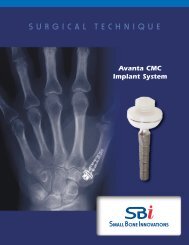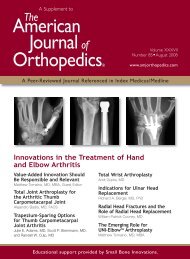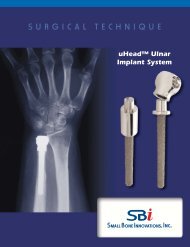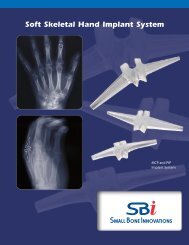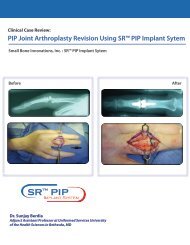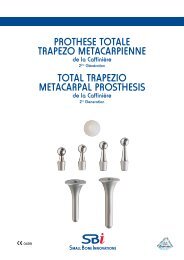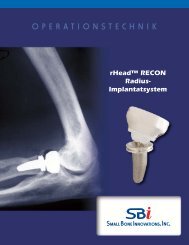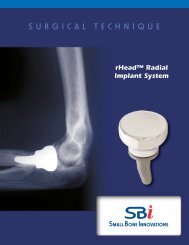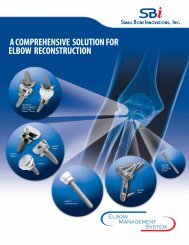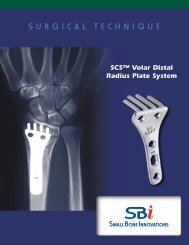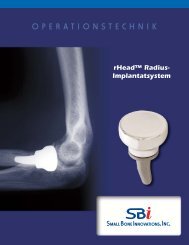PGT INSTRUmENTATIoN - Small Bone Innovations
PGT INSTRUmENTATIoN - Small Bone Innovations
PGT INSTRUmENTATIoN - Small Bone Innovations
You also want an ePaper? Increase the reach of your titles
YUMPU automatically turns print PDFs into web optimized ePapers that Google loves.
Postoperative Treatment<br />
For a minimum of two weeks after surgery, the patient should not bear weight on the operated ankle. The patient should keep the<br />
ankle elevated as much as possible while limiting all physical activities. Partial weight-bearing may begin at 2 to 3-weeks post-operative<br />
and gradually increase until the patient is fully weight-bearing at 4 to 6-weeks post-operative. The ankle cast should typically<br />
be removed six weeks post-operative unless a ligamentous reconstruction was carried out, in which case the cast is left on for a total<br />
of 8 weeks.<br />
Obtaining X-ray<br />
Suggestions for obtaining X-rays for patient follow-up:<br />
All X-rays should be taken using image intensification to provide straight frontal and lateral views. In the frontal views, the<br />
cylindrical anchoring segments of the Tibial Glide Plate must show as circular dots. The X-ray marking wire in the Sliding Core must<br />
form a straight horizontal line parallel to the Tibial Component.<br />
The Talar Component with its lateral wings appears as a rectangle where both the medial and the lateral part of the joint can be seen<br />
into. In the lateral projection, the Tibial Component should render the distal plateau as a straight line. The Talar Component shows<br />
only a straight line. The Talar Component shows only a straight view of one side wing of the Talar Cap.<br />
Additional Information<br />
More detailed information about our implants can be supplied upon request.<br />
Materials used for our orthopaedic implants:<br />
• CoCrMo alloy, ISO 5832-4/ASTM F75<br />
• Commercially Pure Titanium, ASTM F1580<br />
• Stainless Steel, ISO 5832-1/ASTM F138 / ASTM F139<br />
• UHMWPE, ISO 5834-2/ASTM F648<br />
Proper surgical procedures and techniques are necessarily the responsibility of the medical professional. Each surgeon must evaluate the appropriateness of the<br />
surgical technique used based on personal medical training and experience.<br />
The contents of this document are protected from unauthorized reproduction or duplication under U.S. federal law. Permission to reproduce this document<br />
(for educational/instructional use only) may be obtained by contacting <strong>Small</strong> <strong>Bone</strong> <strong>Innovations</strong>, Inc.<br />
Caution: United States federal law restricts the sale of this device to or on the order of a physician.<br />
21



